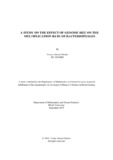| dc.contributor.advisor | Naser, Iftekhar Bin | |
| dc.contributor.author | Shishir, Tushar Ahmed | |
| dc.date.accessioned | 2020-01-23T04:01:51Z | |
| dc.date.available | 2020-01-23T04:01:51Z | |
| dc.date.copyright | 2019 | |
| dc.date.issued | 2019-09 | |
| dc.identifier.other | ID 18376003 | |
| dc.identifier.uri | http://hdl.handle.net/10361/13671 | |
| dc.description | This thesis report is submitted in partial fulfilment of the requirement for the degree of Master of Science in Biotechnology, 2019. | en_US |
| dc.description | Catalogued from PDF version of thesis. | |
| dc.description | Includes bibliographical references (pages 53-57). | |
| dc.description.abstract | Bacteriophages encapsidated by a protein coat have the competency of infecting bacteria, are the most abundant living entities on earth whose genome in general falls into three size ranges and 30-50kbp genetic material containing bacteriophages are most copious encompassing 50% of the whole population whereas bacteriophages containing genome more than 100kbp are only 6%. This uneven distribution of bacteriophages based on genome size points toward the hypothesis, if genome size has any effect on the multiplication rate of the bacteriophages. In response to this proposition, certain tests were put into operation following different parameters to determine their burst-out time, adsorption rate, multiplication rate when both genome size containing phages are co-cultivated, multiplication rate when similar genome size containing phages are co-cultivated, multiplication rate when they are cultivated in absence of other competitors and multiplication rate in presence of other non-specific bacteriophages. The results from these experiments put on show that in spite of genome size, their adsorption rate by hosts is more or less similar but their burst out time varies near around 10 minutes. In addition, their concentration varies three log times since smaller genome containing bacteriophages increases higher in number when co-cultivated however; this variation is negligible the minute when similar genome size containing bacteriophages are cultivated together. This multiplication scheme remains comparable in presence of other non-specific phage as well as when cultured individually. Therefore, this thesis provides an insight that intensification of bacteriophages are greatly sculpted by their genome size, as well as leads to another uncertainty, can we reduce reproduction time of higher animals by chopping out non-coding genome sequences? | en_US |
| dc.description.statementofresponsibility | Tushar Ahmed Shishir | |
| dc.format.extent | 61 pages | |
| dc.language.iso | en | en_US |
| dc.publisher | Brac University | en_US |
| dc.rights | Brac University theses are protected by copyright. They may be viewed from this source for any purpose, but reproduction or distribution in any format is prohibited without written permission. | |
| dc.subject | Bacteriophage | en_US |
| dc.subject | Genome | en_US |
| dc.subject | Multiplication | en_US |
| dc.subject | Replication | en_US |
| dc.subject | Vibrio cholerae | en_US |
| dc.subject | Vibrio phage | en_US |
| dc.title | A study on the effect of genome size on the multiplication rate of bacteriophages | en_US |
| dc.type | Thesis | en_US |
| dc.contributor.department | Department of Mathematics and Natural Sciences, Brac University | |
| dc.description.degree | M. Biotechnology | |

